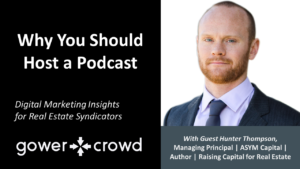WHITE BOARD WORKSHOP
Need More Money to Finance Your Real Estate Projects?
Learn how to find more investors, raise more money, and finance your real estate projects online.
023 How the Fed Influences Interest Rates - A Refresher

Prof. Chris Palmer, UC Berkeley...

Influencing Long Term Interest Rates
The central bank of a country is tasked with changing interest rates and changing the money supply to try to smooth out economic fluctuations to prevent runaway inflation and to keep employment at full growth. Their task is to stabilize the national economy and the way that they do that is by moving around short-term interest rates.
Until recently central banks have had a very strong reluctance to have negative interest rates and from an intuitive perspective this would make sense yet during the great recession that started some ten years ago, the federal funds rate were lowered to next to zero. This left very little maneuvering for the Fed as it tried to stimulate the economy. Attention, therefore, started to drift away from short term interest rates which were at close to zero percent, towards how to lower longer term interest rates that you might see on long term treasuries at around four percent or mortgage rates around four to five percent.
Leaders of The Crowd
Conversations with Crowdfunding Visionaries and How Real Estate Stole the Show
Discover how laws that gave us crowdfunding were solely meant to finance small companies and yet inadvertently opened the doors to allow you to invest in real estate like never before.
Read the book and listen to the actual conversations.
Voracious Buyer of Long Term Debt
That is harder to do because the way that the Fed controls short term rates is it changes the rates that it charges banks trying to get overnight loans from the federal reserve. To influence long term rates, the federal reserve entered the market and became a voracious buyer of long term debt. During QE1 (the first round of quantitative easing), the Fed signaled that it was going to buy long term (30 year) mortgage backed securities. This has the effect of bidding up the price of the bonds which in turn pushes down the yield on the bonds which will be passed through to the corporate sector, and to the household sector. The economy would thus be stimulated by the fed’s acquisition of ten-year treasury bonds and Fannie and Freddie mortgage backed securities, because long term investment decisions such as whether to purchase a house or build a multi-family apartment building or a factory will be facilitated as a result of having lower long term interest rates.
How to Fund Your Deals
7 Steps to Raising Equity Online
Measuring QE Impact
But the question is, does this really work and if it does, how does it work exactly because without seeing the full scope of consequences of such monetary policy there may be unexpected consequences that are more damaging than the problem we were originally attempting to solve. At Berkeley university there is a vast database of anonymized data on properties, on mortgages, and on refinances that is used to assess the impact of these policies on the market.
Palmer looked at who was refinancing, who was taking advantage of these lower interest rates, who is purchasing homes, and what kind of refinancing is going on in what volume, and link those behaviors to monetary policy to see what kind of effect the various QEs were and are having on the economy. Palmer looked at the effect of QE1 where the Fed was buying mortgage backed securities, and QE2 where the Fed looked at buying ten-year treasuries, and then at QE3 where there was a return to acquiring mortgage backed securities in addition to treasury debt. This left the question was one of these strategies more effective than another and if so why.
Conforming vs. Jumbo Loans
Quick aside. Fannie and Freddie buy and guarantee residential mortgage loans that meet several criteria. The loans must have at least 20% down payment, for example, it has to be below the ‘conforming’ loan limit which is in the neighborhood of around $500,000. If it a loan is higher than the defined conforming limit, it is ineligible for purchase by Fannie or Freddie. The Fed is restricted to buying loans guaranteed by Fannie and Freddie so for those communities where house prices are substantially higher than the conforming limits, then the mortgage amounts will be higher also - jumbo loans - so the theory is that these communities would not directly benefit from the QEs which were restricted to only buying conforming loans.
They would not see interest rates come down nearly as much as those communities where loan sizes fell within the conforming loan limits. This allowed Palmer and his colleagues to compare the behavior of communities directly affected by the QEs, i.e. those communities with a predominance of conforming loans, with those less directly affected, i.e. those communities with higher home prices and consequently non-Fannie and Freddie loans.
Tapering QE
Going forward there is less likelihood that the Fed will continue with quantitative easing. As mortgages are paid off because someone sells their home or otherwise pays down their debt, the Fed reinvests the principle that is paid back by buying more Fannie and Freddie debt. One way to taper off the QE stimuli to slowly increase long term interest rates is to stop buying back Fannie and Freddie loans with principle that is paid back. As this happens, the long-term end of the yield curve will start to see an uptick in interest rates and consequently pricing will start to soften and cap rates will go up.
RELATED PODCASTS
338 Hunter Thompson, Managing Principal, ASYM Capital
Last Updated on November 12, 2021 by Dr. Adam Gower FREE TRAINING What is Real Estate Crowdfunding? Learn how to build wealth and earn passive income in real estate while…
READ MORE >364 Jillian Sidoti, Partner at Crowdfunding Lawyers, LLP
Last Updated on June 28, 2020 by Dr. Adam Gower Jillian Sidoti, Partner at Crowdfunding Lawyers, LLP How To Know When Education Becomes Solicitation in CRE Crowdfunding The Investor Acquisition…
READ MORE >325 Scott Smith, Attorney, Royal Legal Solutions
Last Updated on September 15, 2021 by Dr. Adam Gower WHITE BOARD WORKSHOP Need More Money to Finance Your Real Estate Projects? Learn how to find more investors, raise more…
READ MORE >












